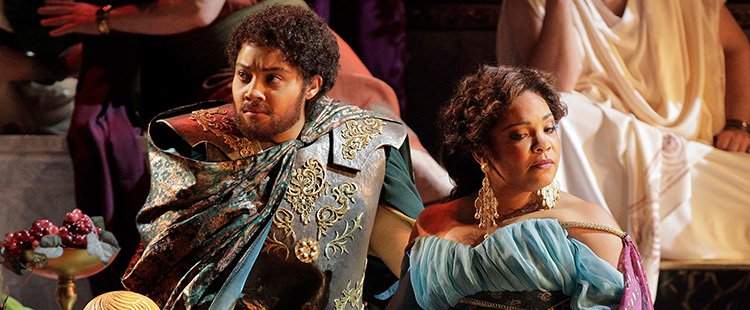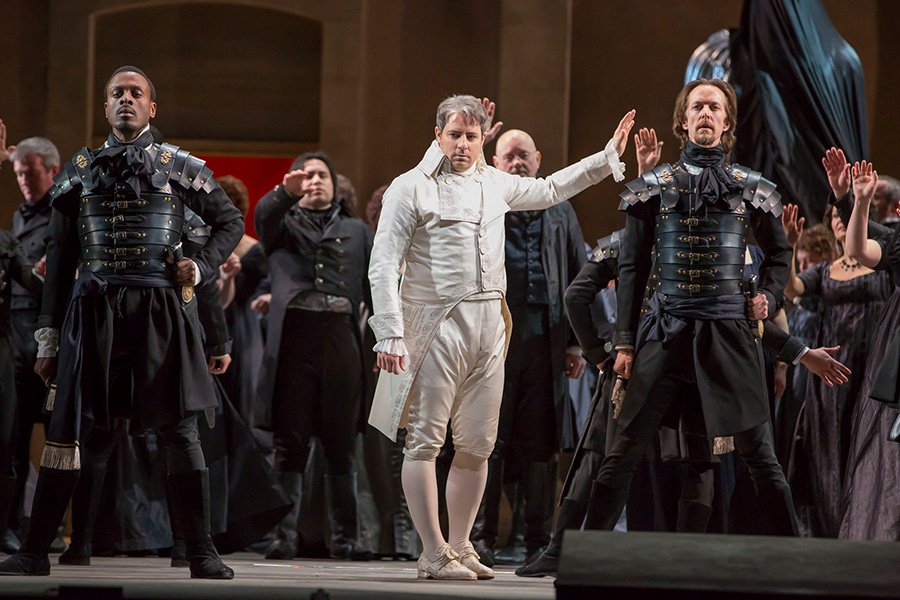By James Conlon
Tutto so, tutti assolvo, e tutto obblio.
(I know everything, I forgive everyone, and I forget everything.)
— Emperor Tito (Act II, final scene)
In 1789, the French populace rose up against their king and queen and brought about a revolution, eventually executing their monarchs. Thirteen years before that, the American colonies had rebelled against the British Crown and established their own sovereign nation.
None of this was lost on royals across the entire continent of Europe, who reacted with alarm and concern. The subject of “good governance,” even by monarchs who claimed to rule by Divine Right, acquired a new urgency. The French Revolution struck especially close to Holy Roman Emperor Leopold II, for Marie Antoinette, the last French queen, was his sister.
So in 1791, when Leopold was to be crowned in Prague, a celebratory opera was to be commissioned. And because one of the contemporary models of Age of Enlightenment authority was that of the “Enlightened Despot,” the new opera could both flatter the new leader and subtly suggest to him an exemplary model of authority. The chosen opera would portray a Roman emperor—and by extension the newly crowned monarch—as not only a man of justice but also of mercy.
Matthew Polenzani returns to the title role of Tito at Ravinia August 12 and 14, having first portrayed the benevolent emperor at the Lyric Opera of Chicago in 2014. (photo: Todd Rosenberg)
The commission went to Mozart. For his subject, he was given a decades-old and frequently reused libretto by Metastasio: La clemenza di Tito or The Clemency of Titus.
An opera, like any other work of art, exists simultaneously within and without its cultural context. Each work is born in a specific time and place, but its inclusion in a corpus of works that we refer to as “repertory” or “canon” is proof that it has withstood the test of time (by whatever moveable criteria we happen to be employing). Just the fact that we view it, listen to it, or watch it in a theater today, is a measure to what degree there is something “immortal” in it.
In today’s world, opera is constantly being scrutinized for relevance. Most of this examination focuses on dramatic and theatrical values. Plot and characters are placed under the microscope of current political, social, and ethical ideas. Texts, by far, provoke knottier challenges than the music. In an overwhelming majority of cases, the text and social context could be considered time bound, but the music isn’t ensnared in the era of its composition. Otherwise we would no longer be listening it. Music itself accords a sense of permanence, a quality of timelessness.
Guanqun Yu portrayed Vitellia in Los Angeles Opera’s 2019 presentation of La clemenza di Tito led by James Conlon, both the company’s and the conductor’s first production of the opera. She reprises the role at Ravinia for the festival’s and the Chicago Symphony Orchestra’s first encounters with the complete opera. (photo: Cory Weaver)
La clemenza di Tito is an interesting example of this duality. Mozart’s penultimate opera (its premiere preceded that of The Magic Flute by 24 days) asks several important questions. A Roman emperor grants clemency—pardon for traitorous actions—as well as forgiveness of personal wrongs. Do these magnanimous acts invite us, in 2022, to reflect on parallels in today’s world?
An astounding number of operas—45, including one by Gluck—were drawn from the original 1734 libretto by Metastasio, the indisputable giant of 18th-century Italian poetry. The story, though overused in Metastasio’s time, is still interesting, important, and relevant. But why is Mozart’s opera still produced on contemporary opera stages and not any of the others? It is, I believe, because Mozart’s genius elevated and reinvigorated what had already become a tired subject. His music renders it seaworthy today.
Mozart’s religious, metaphysical, and social orientation often brought him to the issues of justice, clemency, and forgiveness. They are recurring themes in his works. His three great final works, completed in 1791 during the last four months of his life, symbolically represent three powerful (at times conflicting) forces in his extraordinary spiritual and intellectual soul. They are, in reverse order:
The Requiem Mass (left incomplete at his death on December 5). Although written in response to a commission that he had continually delayed fulfilling, this piece reveals the formidable influence of his Roman Catholic education. It is not only the last but, even in its incomplete form, the greatest of his sacred works.
Conlon led The Magic Flute at Ravinia in 2012, casting Janai Brugger as the First Lady alongside René Barbara as Tamino (left) and Nathan Gunn as Papageno (right). Brugger returns as Servilia in La clemenza di Tito. (photo: Patrick Gipson)
The Magic Flute (premiered on September 30). He accomplished several goals in creating this unique Singspiel: He had produced a work in German with native singers for a non-aristocratic audience. Most important, it was a fairy tale replete with the philosophical, ethical, spiritual, and intellectual symbolism of the Freemasons. He succeeded in expressing (though not revealing) his long-held Masonic principles through popular entertainment. Whatever the conflicts and contradictions between Roman Catholicism and Freemasonry were, they seemed to pose no problem to Mozart.
La clemenza di Tito (premiered on September 6), the work onstage here at Ravinia on August 12 and 14. It tangentially draws from both of Mozart’s two spiritual sources, but is far more secular. The contemporary question of good governance, mentioned above, is central: how does a good and just monarch rule? Mozart answers: with compassion and mercy. The political complexities surrounding the new emperor and Mozart’s probable disinterest in them (his goal was more practical: he needed patronage) are beyond the scope of this essay. But Mozart clearly prizes not just the royal virtue of clemency, but also the personal virtue of forgiveness. The perennial debate pitting justice and mercy as opposing exigencies is surpassed by the Christian concept of absolution. The monarch represents God on earth, less by his self-appointed divine right, but by virtue of his magnanimous generosity of spirit.
In the words of Nicholas Till, author of Mozart and the Enlightenment: Truth, Virtue, and Beauty in Mozart’s Operas, “Mozart’s Clemenza is not a conventional hymn to enlightened despotism, as is usually claimed, but a missile lobbed in the aristocratic counter-revolution to absolutism.” The aristocracy, represented by the Bohemian Estates, vigorously debated the emperor’s power to pardon, partly in response to perceived imperial abuse. Similar tensions can be sensed within today’s political environment.
The monarch attains the divine Godhead (to paraphrase The Magic Flute) when he/she exercises forgiveness, not just mercy. Imperial clemency (or presidential pardons) rescind the punishment while acknowledging guilt. Forgiveness goes further. It cancels the offense itself. Tito, the emperor, pardons the crime and its punishment. Tito, the man, forgives and blesses the perpetrators.
Brugger as Servilia at Los Angeles Opera in 2019 (photo: Cory Weaver)
Political intrigue interested Mozart only to a certain degree. His subject is always love with all of its joy and turmoil. The contrasts of the positive and negative aspects of love is drama’s dynamic. Renunciation, in the composer’s mind, is a close cousin of love: Servilia renounces the throne for love; Sesto his honor, in order to serve Vitellia’s scheming; and Vitellia her life, to save Sesto. Tito renounces personal love altogether for his devotion to Rome. With his forgiveness he sanctions everyone else to live as amorous couples, excluding himself to preserve his devotion to his patriotic duty.
The frequent demonstration of clemency, pardon, or forgiveness by Mozart’s characters is impressive, although occasionally ambiguous. The Countess (Marriage of Figaro), Donna Elvira (Don Giovanni), and Pasha Selim (Abduction from the Seraglio) are the most prominent models of forgiveness. Susanna (Figaro), Konstanze, and Blöndchen (both Seraglio) easily forgive smaller offenses. Ferrando and Guglielmo (both Così fan tutte) pardon their errant lovers—but do they forgive them? In The Magic Flute, Sarastro preaches forgiveness but nevertheless punishes Monostatos and the Queen of the Night. Elettra (Idomeneo) cannot forgive, and hence condemns herself. Mozart himself seems to forgive everyone—except Don Giovanni, whose abominations are too great. Divine justice itself decrees his punishment. [Read more on this subject in “Don Giovanni, the Unknowable, a classical antihero.”]
Tito is the culmination of this chain. We recognize the strength and self-confidence of those who rule with goodness. When the monarch knows the meaning of clemency and forgiveness, the common good is served. Tito knows not only these, but the power of dedication and service to his people: “Oh eternal gods, cut short my life on the day that Rome will not be my care.” And when he says that, it should be noted in Rome ch’io tutto so [that I know everything], we recognize the worthy leader; tutti assolvo [I absolve everyone], we acknowledge his willingness to annul the punishment of transgressors; e tutto obblio [and I forget everything], we celebrate his Godlike, transcendent value of forgiveness.
By September 6, 1791, Mozart had set those words to music. With those words, he had already prepared himself for his appointment with destiny. Just three months later, he was dead. ●
© James Conlon 2019, revised 2022





